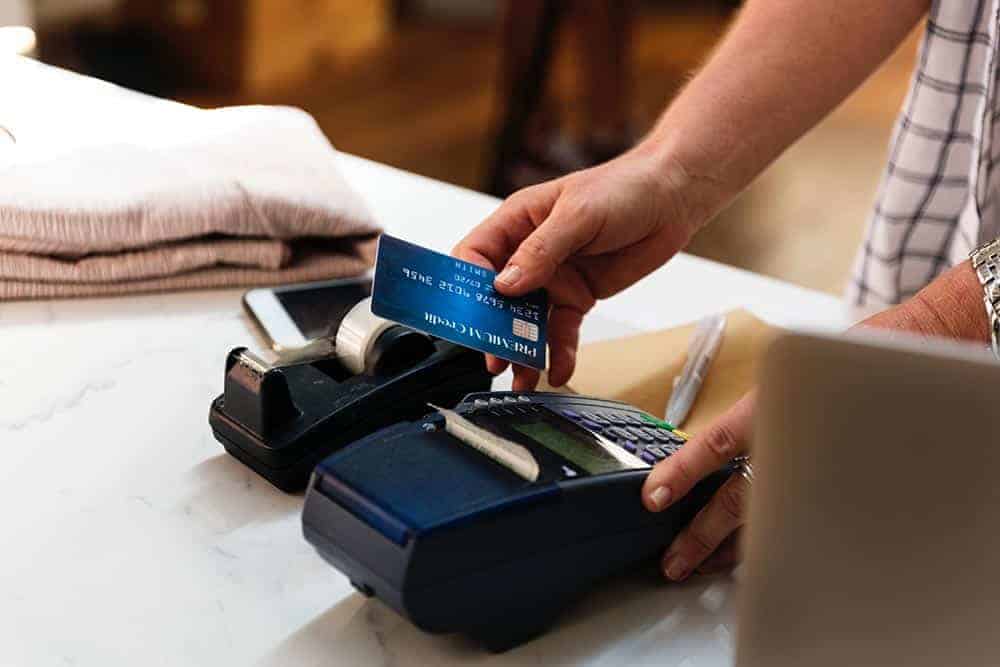In the last 60 years, the credit card has evolved from a status symbol to a mainstay in the wallets of people all over the world. Case in point, in 1970, only 16% of Americans owned a credit card. Today, 70.2 % of Americans own one.
The number of credit card owners has increased by 4.1% since 2016 and on average, 35% of Americans own 1 to 2 types of plastic.
The popularity of the use of credit cards grew alongside the development of technology and telecommunications. As innovations in electronic payment systems improved, so did the confidence of retailers to accept the credit card as a method of payment.
Thus, with more than 183 million card-carrying Americans looking around for the best deals in town, it only makes sense to allow credit card payments in your establishment.
However, does it make good business sense to charge customers extra for opting to use their credit card to pay for their purchases?
The Credit Card Conundrum – Boon Or Bane For Customers?
There are a number of good reasons why customers love to use their credit card to pay for goods and services.
- Convenience – No need to carry around a bulky wallet stuffed with bills and coins or a checkbook. A credit card is valuable when traveling to another country.
- Safe – If your credit card should get stolen, all you have to do is inform the issuing company about the incident. The card company will suspend your account and conduct a review of the transactions made since the time you reported the crime. After an investigation has been made, the charges can be reversed and a new card issued to you.
- Cash Flow Management – Did your laptop send its final email before the motherboard kicked the circuit board for good? If your cash is tight but you expect some payments to come in by next month, use your credit card to buy a new laptop. You can pay for the laptop in affordable monthly installments until such time that you can settle the obligation in full.
- Improve Credit Score – The credit card company will send a record of your transactions to the Credit Bureau. If you are a responsible credit card holder and pay your bills on time, your credit rating will improve.
In addition to being a business owner, you are most likely a credit cardholder who has enjoyed first-hand the benefits of paying with a Mastercard or Visa instead of cash.
However, as a business owner, you may have come to realize that the grass is not greener on the other side of the fence.
While the use of a credit card gives the customer more convenience, it adds to the cost of business of the entrepreneur. There is a cost to the business owner for having these credit card payments processed.
Furthermore, the business owner has to pay for the software and hardware that supports the credit card payment system.
All in all, these costs add up to around 4% of the purchase price for the account of the business owner.
In 2013, new rules were set in place that allowed businesses which accepted credit card payments to apply a surcharge on all card transactions.
Under the new rules, a retailer could present a specific price for an item but charge higher to customers who opt to pay for the same item via credit card.
In effect, the additional cost of processing the credit card payment would be passed on to the customer.
For the business owner, if he priced the item at $50, he is assured of getting paid $50 whether cash or credit card was used to make the purchase.
The Credit Card Surcharge – Is It A Tax On Convenience?
To be clear, the surcharge is not intended for the business owner to make more money from customers who prefer to pay with a credit card.
Rather, the purpose of the surcharge is to help the business owner to recover the cost of processing the credit card payment.
And this is where we have a moral dilemma:
Should the customer who chooses to pay for the item with a credit card be made accountable for the business owner’s cost of doing business?
The surcharge creates a conundrum for the use of the credit card: It protects the business interests of the entrepreneur but penalizes the customer for choosing the convenience of paying via credit card.
The conundrum has triggered multiple discussions on whether applying surcharges is a legalized way of infringing upon the right of the consumer to choose the method of payment.
Depending on the capability of the retailer, a consumer has the following options to pay for his purchase:
- Cash
- Check
- Credit Card
- Debit Card
The reasons behind the decision to prefer the credit card as the method of payment over cash, check or debit card will vary from one customer to another.
- The ATM could be offline; Customer A had no choice but to use his credit card.
- Customer B has cash flow problems because his clients had not yet paid for his company’s services.
- Customer C had his wallet stolen including his ATM card and has asked his wife to pay for the item with her credit card.
- Customer D wants to avail of the convenience of paying with a credit card and accumulate reward points from the card issuer.
In the first 3 examples, the customers’ decisions were influenced by factors beyond their control. It was possible that if they had the opportunity to pay with cash, they would have. However, circumstances dictated otherwise.
Why should these customers be penalized for the inconveniences that were the fault of others?
If the surcharge is meant to get consumers to understand the plight of the business owner, should the business owner be made to understand the plight of the consumer?
Obviously, the customer should not be “interrogated” on why he decided to pay for the purchase with his credit card – that is his right to choose as a customer.
Besides, the obligation of the business owner is to offer products and services. He cannot arbitrarily decide who gets to pay with a credit card and who doesn’t.
In view of this, the surcharge acts as a tax on the consumer’s right to favor convenience.
The surcharge is not a sustainable pricing strategy because it protects only the seller but penalizes the buyer for exercising his right to choose the credit card as the method of payment.
From the perspective of the customer, the surcharge negatively impacts consumerism – the protection of the rights and interests of the consumer.
Sustainable Pricing Strategies – Do They Exist?
Countries such as the United Kingdom and the Philippines have banned the practice of imposing surcharges on credit card transactions.
Should other countries like the United States – the most powerful economy in the world – follow suit and terminate the practice of surcharging on purchases made with a credit card?
The best solutions are sustainable solutions. This means the proposed solution should benefit all parties – the consumer, the business owner, and the credit card processor.
Is it possible to come up with sustainable pricing strategies that will protect the interests of the consumer, the business owner, and the credit card processing company?

1. Single Pricing System
Since the credit card company has to cover its expenses in processing the credit card transactions, it will pass on the added cost to the business owner.
As such, the business owner should consider the processing charges as a cost of doing business and factor it in his overall pricing strategy.
By factoring the cost of credit card processing into his pricing matrix, the business owner will be able to come up with a single pricing system that will not discriminate versus the consumer.
The processing charges can simply be added as part of the pricing matrix’s “Contingency Expenses” – those items which may contribute to the cost of sales such as an increase in the price of materials, foreign exchange rate, and wastage to name a few.
Under a single-pricing system, there will only be one price posted per item. There will be no distinction if the purchase will be made via cash, check, debit card or credit card.
A single-pricing system is sustainable because it protects the interests of the parties involved.
The consumer is not penalized for using his credit card, the credit card processing company covers the added cost and the business owner gets paid in full.
2. Convenience Fees
Convenience Fees are often mistakenly interchanged with surcharge fees. The difference between the 2 fees is that the cost of the surcharge is determined by the credit card company.
In contrast, the amount of the Convenience Fee is determined by the business owner. However, the purpose is the same – to tax the consumer the convenience of using a credit card so that the business owner can recover his expenses.
The best way to implement the convenience fee is to introduce a different avenue for making a purchase – an avenue whereby the use of the credit card becomes a necessity.
A good example would be to provide online delivery services. When a customer visits the business owner’s website to make a purchase, the only way to facilitate the transaction would be to use a credit card.
Under this pricing strategy, the business owner can also factor in other expenses in addition to the processing fees. These add-on expenses may include delivery or shipping charges, labor, and warehousing costs.
3. Discounting Policies
Another objective of surcharging is to discourage the customer from using his credit card and instead opt for cash or check payments which do not carry transaction fees.
“To discourage” has a negative connotation. A better approach would be to encourage customers to pay via cash by offering attractive discounts on cash purchases.
For example, a product may have a single price of $100. However, if a buyer decides to pay cash, he would be given a 4% discount.
A savvy business owner would already factor in the 4% discount in his pricing matrix. Therefore, he does not lose anything and may gain more customers because of the discount.
The discounting pricing strategy would increase the number of cash sales and any credit card transaction would just pad the business owner’s margins a bit more.
Conclusion
The credit card was borne out of convenience. In the 1800s, charge plates were extended to farmers which afforded them the time to pay for their bills once their crops were harvested and sold.
In 1946, the Charg-It card was created to help merchants get paid while the banks – the “middlemen” – collected payment from the customer. By 1950, the first incarnation of the modern-day credit card – the American Express Card – was introduced worldwide.
Today, the credit card has taken new forms to provide more convenience and greater ease of use. The prime example would be Apple Pay, a digital wallet service from Apple, that allows users to pay via the iOS mobile platform or via the Internet.
Given its history of providing both consumers and business owners convenience, the credit card should be celebrated not chastised.
The idea of penalizing consumers who exercise their right to use credit as a means of payment is tantamount to imposing a tax on convenience.
At the same time, we should also understand the plight of small business owners who may have tight funds or limited access to capital.
4% may not sound like much but over time, the numbers will add up and eventually compromise his limited profit margin.
Instead of a surcharge, businesses are best advised to implement sustainable pricing strategies that provide a win-win-win proposition for all the parties involved.
What is your opinion on the practice of surcharging on credit cards? Do you have other sustainable pricing strategies in mind? Please feel free to share your ideas in our comment section.
If you enjoyed this article and would like similar content for your website, give us a call or an email. Let’s find time to discuss your content marketing strategy!






